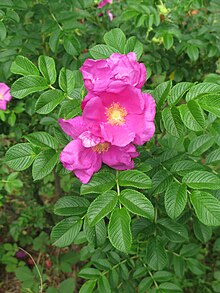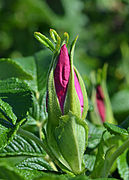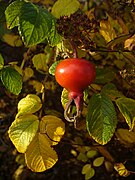
A rose is either a woody perennial flowering plant of the genus Rosa, in the family Rosaceae, or the flower it bears. There are over three hundred species and tens of thousands of cultivars.They form a group of plants that can be erect shrubs, climbing, or trailing, with stems that are often armed with sharp prickles. Their flowers vary in size and shape and are usually large and showy, in colours ranging from white through yellows and reds. Most species are native to Asia, with smaller numbers native to Europe, North America, and northwestern Africa. Species, cultivars and hybrids are all widely grown for their beauty and often are fragrant. Roses have acquired cultural significance in many societies. Rose plants range in size from compact, miniature roses, to climbers that can reach seven meters in height. Different species hybridize easily, and this has been used in the development of the wide range of garden roses.

Rosa laevigata, the Cherokee rose, is a white, fragrant rose native to southern China and Taiwan south to Laos and Vietnam, and invasive in the United States.

Rosa multiflora is a species of rose known commonly as multiflora rose, baby rose, Japanese rose, many-flowered rose, seven-sisters rose, Eijitsu rose and rambler rose. It is native to eastern Asia, in China, Japan, and Korea. It should not be confused with Rosa rugosa, which is also known as "Japanese rose", or with polyantha roses which are garden cultivars derived from hybrids of R. multiflora. It was introduced to North America, where it is regarded as an invasive species.

Hibiscus rosa-sinensis, known colloquially as Chinese hibiscus, China rose, Hawaiian hibiscus, rose mallow and shoeblack plant, is a species of tropical hibiscus, a flowering plant in the Hibisceae tribe of the family Malvaceae. It is widely cultivated as an ornamental plant in the tropics and subtropics.

Rosa glauca, the red-leaved rose or redleaf rose, is a species of rose native to the mountains of central and southern Europe, from the Spanish Pyrenees east to Bulgaria, and north to Germany and Poland. It is also found as an introduced species as far north as Scandinavia and Finland.
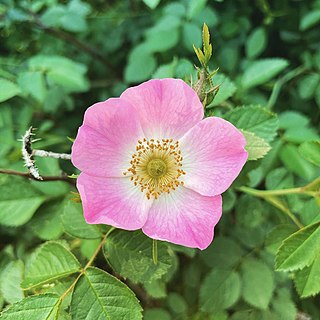
Rosa rubiginosa is a species of rose native to Europe and western Asia.

Rosa gallica, the Gallic rose, French rose, or rose of Provins, is a species of flowering plant in the rose family, native to southern and central Europe eastwards to Turkey and the Caucasus. Rosa gallica was one of the first species of rose to be cultivated in central Europe. It is a parent of several important cultivars.

Jules Léopold Gravereaux was a French rosarian. He was a top executive at the department store Le Bon Marché and in 1892 purchased land at the village of L'Haÿ about 8 km south of Paris. There, he built the first ever complete garden devoted exclusively to roses, the Roseraie de L'Haÿ. It became so popular that a few years later the village changed its name to L'Haÿ-les-Roses.

Rosa chinensis, known commonly as the China rose, Chinese rose, or Bengal rose, is a member of the genus Rosa native to Southwest China in Guizhou, Hubei, and Sichuan Provinces. The first publication of Rosa chinensis was in 1768 by Nikolaus Joseph von Jacquin in Observationum Botanicarum, 3, p. 7 & plate 55.

Rosa gymnocarpa is a species of rose native to western North America. It is known by the common names dwarf rose, baldhip rose, and wood rose. It grows in shady, damp, and rich forests.

Rosa 'Mrs Fred Danks' is a hybrid tea rose cultivar which was bred by Alister Clark (1864–1949), and introduced after his death in Australia in 1952. The plant was named after a friend of Clark's.

Rosa woodsii is a species of wild rose known by the common names Woods' rose, interior rose, common wild rose, mountain rose, pear-hip rose, and prairie rose.

Garden roses are predominantly hybrid roses that are grown as ornamental plants in private or public gardens. They are one of the most popular and widely cultivated groups of flowering plants, especially in temperate climates. An enormous number of garden cultivars have been produced, especially over the last two centuries, though roses have been known in the garden for millennia beforehand. While most garden roses are grown for their flowers, often in dedicated rose gardens, some are also valued for other reasons, such as having ornamental fruit, providing ground cover, or for hedging.

Rosa blanda, commonly known as the smooth rose, meadow/wild rose, or prairie rose, is a species of rose native to North America. Among roses, it is closest to come to a "thornless" rose, with just a few thorns at the base. The meadow rose occurs as a colony-forming shrub growing to 1 m (3.3 ft) high, naturally in prairies and meadows. The roses are quite variable, the characteristics such as leaf tip number of prickles and glandular hairs usually do not always remain constant, thus it is often confused with Rosa arkansana or Rosa carolina, the two other prairie rose species.

Stevenston Beach is a Local Nature Reserve (LNR), located between Stevenston and Saltcoats in Scotland. It is situated on the coast, west of the Stevenston Burn. The park covers an area of 12 ha, and consists mostly of sand dunes, with an area of coal mining spoil derived from Auchenharvie Colliery No. 5 pit which produced Ladyha' coal. It is ranked as the fifth most important sand dune system in Ayrshire. The dunes are also designated as a wildlife site by the Scottish Wildlife Trust.
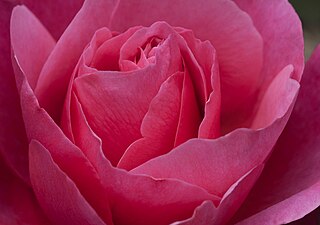
Rosa 'Line Renaud', rose code name MEIclusif, is a hybrid tea rose cultivar bred in France by Meilland International SA and introduced in 2006. It was named for French actress Line Renaud.
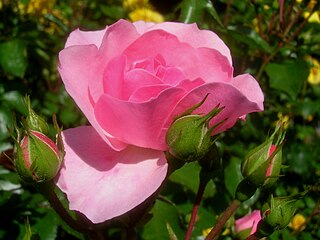
Rosa 'Bonica 82',, is a shrub rose cultivar, bred by Marie-Louise Meilland in France in 1982. The cultivar was named an All-America Rose Selections winner in 1987.

Rosa 'Albertine' is a salmon-pink hybrid wichurana, a large-flowered rambling rose that blooms in clusters once a year. The cultivar was bred by René Barbier before 1921 and introduced into Australia by Hazlewood Bros. Pty. Ltd. in 1923 as "Albertine". It has been awarded the Award of Garden Merit (AGM) by the Royal National Rose Society (RNRS) in 1993.

Rosa 'Alexandre Girault' is a deep cherry pink hybrid wichurana, a large-flowered climbing rose. The cultivar was bred by René Barbier in 1907. The rose was awarded the Award of Garden Merit (AGM) by the Royal National Rose Society (RNRS) in 2012.

Rosa 'Paul Transon' is a salmon-pink hybrid wichurana. The cultivar was bred by French rose hybridizer, René Barbier in 1900. The rose was awarded the Award of Garden Merit (AGM) by the Royal National Rose Society (RNRS) in 1993.
